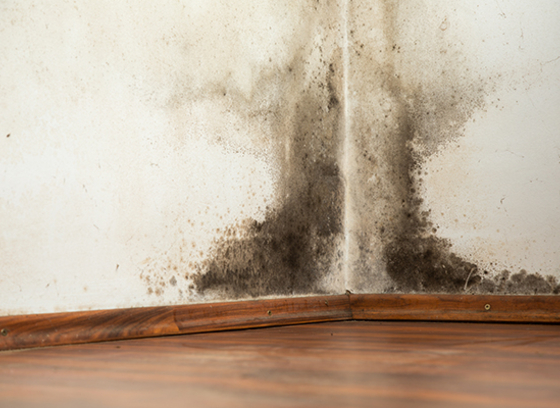Mold Facts
Molds are microscopic forms of fungi that grow into visible colonies under the right conditions. They are found everywhere – both indoors and outdoors year-round. Outdoors, molds live in the soil, on plants and on dead or decaying matter. Another common term for mold is mildew. Mold growth is encouraged by warm and humid conditions, although it can grow during cold weather also. There are many thousands of species of mold and they can be in any color, including white, orange, green, brown or black. Many times, mold can be detected by a musty odor. Most fungi, including molds, produce microscopic cells called “spores” that spread easily through the air. Live spores act like seeds, forming new mold growths (colonies) when they find the right conditions. All of us are exposed to fungal spores daily in the air we breathe, both outside and inside. This and the following information is from Maryland Department of Health's Mold Fact Sheet.

How does mold get into a house or building?
Most, if not all, of the mold found indoors comes from outdoor sources. Indoors it seems to grow and become a problem only where there is water damage, high humidity or dampness. All molds need moisture to grow. Common sources of indoor moisture that can cause mold problems include flooding, roof and plumbing leaks, damp basements or crawl spaces. Any place where moist air condenses on cold surfaces may be a source of mold.
Why are we concerned about mold?
Small amounts of mold growth in workplaces or homes are not a major concern. When molds are present in large quantities, they may cause nuisance odors and health problems for some people.
How do molds affect people?
Most people will have no reaction at all when exposed to molds. Allergic reactions, similar to common pollen or animal allergies, including runny nose, eye irritation and skin rash, are the most common health effects for individuals sensitive to molds. Flu-like symptoms, such as cough, congestion, headache and fatigue may occur. Molds may also aggravate asthma. Fungal infections from building-associated molds may occur in people with serious immune disease, but this is very rare. Most symptoms are temporary and eliminated by correcting the mold problem.
Who is affected by exposure to mold?
For those who are affected by mold exposure, there can be a wide variation in how they react. Some individuals are more sensitive than others. Some general groups that tend to be more sensitive include:
- Infants and children
- Individuals with respiratory conditions or allergies and asthma.
- Persons with weakened immune systems (for example, people with HIV infection, chemotherapy patients, organ or bone marrow transplant recipients, or those with autoimmune diseases.)
Those with special health concerns should consult their doctor if they are concerned about mold exposure. The symptoms that may seem to occur from mold exposure can also be due to other causes, such as bacterial or viral infections or other allergies.
Can mold be toxic?
Some molds can produce toxic substances called mycotoxins. Airborne mycotoxins have not been shown to cause health problems to occupants in residential or commercial buildings. The health effects of breathing mycotoxins are not well understood and are currently under study.
What is “black mold”?
The news media sometimes refer to “black mold” or “toxic black mold.” It has usually been associated with the mold Stachybotrys chartarum, a type of greenish-black mold commonly associated with heavy water damage. Known health effects are similar to other common molds. Early reports of severe effects have been put in doubt by later research.
What should I do if I see or smell mold?
An important and very practical step in solving a mold problem is to identify and fix the moisture sources that caused the mold growth. For small mold problems, detergent and water can be used to wash mold off hard surfaces. Bleach solution kills mold. Porous or absorbent materials (such as ceiling tiles, wallboard and carpeting) that become moldy should be replaced.
What about testing the building for mold?
Mold and moldy odors seldom require testing. The first step should be to inspect for water damage and any visible mold growth. The next step would be to get rid of any visible mold and to solve any moisture problem causing a moldy condition. There are no standards for “acceptable” or “unacceptable” levels of mold in buildings. Any testing should be done by a trained specialist.
How can people decrease mold exposure?
Keep humidity levels as low as you can—no higher than 50%–all day long. An air conditioner or dehumidifier will help you keep the level low. Bear in mind that humidity levels change over the course of a day with changes in the moisture in the air and the air temperature, so you will need to check the humidity levels more than once a day.
- Use an air conditioner or a dehumidifier during humid months.
- Be sure the home has adequate ventilation, including exhaust fans.
- Add mold inhibitors to paints before application.
- Clean bathrooms with mold killing products.
- Do not carpet bathrooms and basements.
- Remove or replace previously soaked carpets and upholstery.
The Howard County Health Department does not have a program to evaluate mold concerns or provide assistance for addressing mold-related problems. However, additional general information about mold and mold cleanup can be accessed through these links.